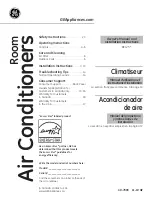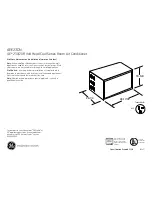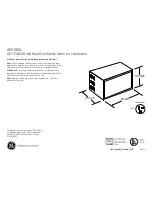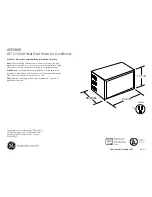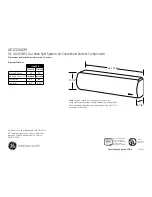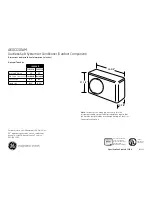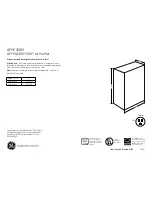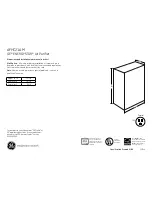
OPERATIONS
PAGE 24
ENGLISH
10.2.6 Forced Defrost Operation
The system can be placed into a forced defrost cycle from the
wired controller. The system will remain in defrost until sensor
Te has sensed 53.6°F for at least 1 minute or until the defrost
cycle has reached 10 minutes total runtime.
A forced defrost cycle can be initiated with the compressor
off. The system will enter a 3 minute time delay prior to
energizing the compressor.
10.2.7 Defrosting Time Flowchart
10.2.7 Defrosting operation flow chart:
beginning
end
fixed frequency
indicated FQY 60s
defrosting FQY 80 Hz
(
E
)
60s
soft startup
compressor
0HZ
0HZ
5s
outdoor motor ON
send defrosting signal to indoor
Auto
OFF
4-way valve
ON
OFF
15s
450-pulse
450-pulse
350-pulse(E)
all EEVs
auto open angle
auto open angle
all indoor motors ON
OFF
anti-cold air function
69
10.2.8 Frequency Control and Compressor Discharge Line
Temperature
If the temperature of the discharge line gets too high, and
the EEV adjustment cannot correct the problem, the ECU will
make frequency adjustment to the speed of the compressor
in an attempt to cool it down. The chart here shows the
adjustment steps versus the discharge line temperature.
10.2.8 Frequency Control when there is CT Over-current
Protection
10.2.8 Frequency control when compressor discharge temp.
(
Td
)
is too high
Purpose: make compressor frequency control if the discharging temp. is too high, to lower the discharging
temp. efficiently and ensure the system can run normally.
Multi:
Dischar
gin
g
tem
p.
TD
Reduce FQY rapidly 2HZ/S
Reduce FQY rapidly 1HZ/S
Reduce FQY slowly 1HZ/10S
Remain FQY
Increase FQY slowly 1HZ/10S
If keeping for 10s, the unit stops, 3 minutes later, the unit can
re-startup. If in 60 minutesthe unit occurs alarm for 3 times, the
failure can be eliminated.
248
℉
239
℉
230
℉
221
℉
212
℉
203
℉
70
Co
nde
ns
in
g t
em
p.
Keep for 5 seconds, stop to alarm, after 3-minute standby, the
unit will stop to alarm and the failure can be resumed after being
electrified again.
Reduce FQY rapidly 2HZ/S
Reduce FQY rapidly 1HZ/S
Reduce FQY slowly 1HZ/10S
Remain FQY
Increase FQY slowly 1HZ/10S
1.0 I
0.95I
0.93I
0.90I
0.88I
0.85I
Stop immediately, if abnormal stop 3 times in 1 hour, the
unit will stop and alarm.
Reduce FQY rapidly 2HZ/S
Reduce FQY rapidly 1HZ/S
Reduce FQY slowly 1HZ/10S
Remain FQY
Increase FQY slowly 1HZ/10S
unit can restartup. In 60 minutes it occurs 3 times continously,
10.2.8.
10.2.9.
When the input signal of pressure switch is low level: 0 for 1 minute, that shows high pressure
10.2.10.
(1) When compressor is running, if output signal of low pressure switch is low level: 0 for 1
(2) When compressor no running, if output signal of low pressure switch is low level: 0 for 30
156
℉
154
℉
151
℉
147
℉
144
℉
140
℉
code to indoor. Meanwhiel, by controling the max. condensating temp.Tc(cooling) or module temp. sensor(TmAVE),
please confirm as follow
71
10.2.9 High Pressure Protection
If abnormally high refrigerant circuit condensing pressure is
detected, the high pressure switch will open. The outdoor unit
will initiate an Error Code and stop compressor operation. If
the system pressure drops enough to re-close the switch the
system will re-start. If the failure occurs 3 times, the system
will lock out and display the appropriate Error Code.
High condensing temperature can also cause high pressure.
The ECU will monitor the temperature of the condensing coil
in both heating and cooling modes of operation. Frequency
adjustments will be made to the compressor speed in an
attempt to manage high pressure that can be caused by dirty
condensing coils and high heat loading. The chart below shows
the ECU frequency response at high condenser temperatures.
(Indoor Coil Heat Mode, Outdoor Coil Cool Mode)
Co
nde
ns
in
g t
em
p.
Keep for 5 seconds, stop to alarm, after 3-minute standby, the
unit will stop to alarm and the failure can be resumed after being
electrified again.
Reduce FQY rapidly 2HZ/S
Reduce FQY rapidly 1HZ/S
Reduce FQY slowly 1HZ/10S
Remain FQY
Increase FQY slowly 1HZ/10S
1.0 I
0.95I
0.93I
0.90I
0.88I
0.85I
Stop immediately, if abnormal stop 3 times in 1 hour, the
unit will stop and alarm.
Reduce FQY rapidly 2HZ/S
Reduce FQY rapidly 1HZ/S
Reduce FQY slowly 1HZ/10S
Remain FQY
Increase FQY slowly 1HZ/10S
unit can restartup. In 60 minutes it occurs 3 times continously,
10.2.8.
10.2.9.
When the input signal of pressure switch is low level: 0 for 1 minute, that shows high pressure
10.2.10.
(1) When compressor is running, if output signal of low pressure switch is low level: 0 for 1
(2) When compressor no running, if output signal of low pressure switch is low level: 0 for 30
156
℉
154
℉
151
℉
147
℉
144
℉
140
℉
code to indoor. Meanwhiel, by controling the max. condensating temp.Tc(cooling) or module temp. sensor(TmAVE),
please confirm as follow
71
10.2.10 Low Pressure Protection
The system low pressure switch is normally closed. The
switch will open when the refrigerant pressure gets too low.
Typical causes are refrigerant leaks/undercharging and low
evaporator heat loading. The system will auto re-start if the
switch re-closes after opening. If the switch opens 3 times in
60 minutes of running, the system will display an error code.
The low pressure switch is checked even when the system
is off. This protects the compressor against operating with a
great loss of refrigerant when the system has been off for a
long time.
OUTDOOR UNIT TEMPERATURE SENSOR RESPONSES
Forced Defrost Operation
Summary of Contents for AW07LC2VHA
Page 3: ...PAGE 3 ENGLISH INTRODUCTION SPECIFICATIONS Multi Zone Indoor...
Page 4: ...PAGE 4 ENGLISH INTRODUCTION SPECIFICATIONS Multi Zone Indoor...
Page 5: ...PAGE 5 ENGLISH INTRODUCTION SPECIFICATIONS Multi Zone Outdoor...
Page 73: ...REFERENCES PAGE 73 ENGLISH Component Ratings REFERENCES...
Page 76: ...REFERENCES PAGE 76 ENGLISH Wiring REFERENCES...
Page 77: ...REFERENCES PAGE 77 ENGLISH Wiring REFERENCES...
Page 78: ...REFERENCES PAGE 78 ENGLISH Wiring REFERENCES...
Page 79: ...REFERENCES PAGE 79 ENGLISH Wiring REFERENCES...
Page 80: ...REFERENCES PAGE 80 ENGLISH Wiring REFERENCES...
Page 81: ...REFERENCES PAGE 81 ENGLISH 2U Wiring REFERENCES...
Page 82: ...REFERENCES PAGE 82 ENGLISH CN20 Connector for room card Wiring REFERENCES...
Page 83: ...REFERENCES PAGE 83 ENGLISH SWI Wiring REFERENCES...
Page 84: ...REFERENCES PAGE 84 ENGLISH Wiring REFERENCES...
Page 86: ...REFERENCES PAGE 86 ENGLISH CIRCUIT DIAGRAMS REFERENCES...
Page 87: ...REFERENCES PAGE 87 ENGLISH CIRCUIT DIAGRAMS REFERENCES...
Page 88: ...REFERENCES PAGE 88 ENGLISH WIRING DIAGRAMS REFERENCES...
Page 89: ...REFERENCES PAGE 89 ENGLISH WIRING DIAGRAMS REFERENCES...
Page 90: ...REFERENCES PAGE 90 ENGLISH 2U Piping Installation Dimensions REFERENCES...
Page 92: ...REFERENCES PAGE 92 ENGLISH Refrigerant Diagram REFERENCES...
Page 93: ...REFERENCES PAGE 93 ENGLISH Refrigerant Diagram REFERENCES...
Page 94: ...REFERENCES PAGE 94 ENGLISH 3U Piping Installation Dimensions REFERENCES...
Page 95: ...REFERENCES PAGE 95 ENGLISH 4U Piping Installation Dimensions REFERENCES...
Page 110: ...REFERENCES PAGE 110 ENGLISH SENSORS Value of Thermistor Indoor Unit...
Page 111: ...REFERENCES PAGE 111 ENGLISH SENSORS...
Page 112: ...REFERENCES PAGE 112 ENGLISH SENSORS...
Page 113: ...REFERENCES PAGE 113 ENGLISH SENSORS...
Page 114: ...REFERENCES PAGE 114 ENGLISH SENSORS...
Page 115: ...REFERENCES PAGE 115 ENGLISH SENSORS...
Page 116: ...REFERENCES PAGE 116 ENGLISH SENSORS...
Page 117: ...REFERENCES PAGE 117 ENGLISH SENSORS...
Page 118: ...REFERENCES PAGE 118 ENGLISH SENSORS...
Page 119: ...REFERENCES PAGE 119 ENGLISH SENSORS...
Page 120: ...REFERENCES PAGE 120 ENGLISH SENSORS...


































